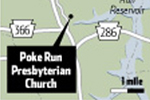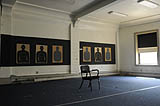
Category Archive: Easements
-
Trail Envisioned as Enriching Youghiogheny Towns
By Stacey Federoff
TRIBUNE-REVIEW
Wednesday, September 15, 2010The Great Allegheny Passage trail generates $40 million a year in economic spending, and a preservation plan is intended to use historic preservation in six trail towns to harness that spending power.
A meeting Tuesday night in West Newton hosted by the Progress Fund’s Trail Towns Program organized preliminary goals and objectives for that plan.
Meetings were open to the six communities — West Newton, Connellsville, Ohiopyle, Confluence, Meyersdale and Rockwood — in March to gather ideas.
This second round of workshops, including one at noon today at the Ohiopyle-Stewart Community Center in Ohiopyle and another at 6:30 p.m. at the Turkeyfoot Valley Historical Society in Confluence, are meant to make sure the project was on the right track.
“The purpose of these meetings is to test our information,” said Matt Goebel, vice president of Clarion Associates of Denver, a preservation planning firm assisting with the project. “We’re continuing to seek input as much as we can throughout this whole process.”
About 15 people, many of whom were officials involved in the plan, were on hand in West Newton, but Goebel said the plan is trying to include more than just historical societies and preservation agencies.
“A big theme of this project is that preservation needs to move beyond the usual suspects,” he said, branching out to local governments or chambers of commerce.
One of the group’s goals is to identify common industries and cultural landscapes while continuing to preserve each of the towns’ authenticity.
“We want the trail towns hopefully to work together, but we also want you to own who you are and what makes you unique,” said Erin Hammerstedt of Preservation Pennsylvania.
She pointed out potential areas for preservation in each town, complimenting the classic downtowns in West Newton and Connellsville.
The organizations hope to have a draft plan prepared this fall and begin implementing it by year’s end.
-
Blight-Fighting Pennsylvania Bill Targets Vacant Buildings
By Craig Smith
PITTSBURGH TRIBUNE-REVIEW
Monday, September 27, 2010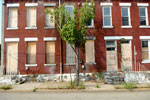
Vacant properties at 1103-1105 Fulton St. mar the Manchester section of the North Side. Philip G. Pavely/Pittsburgh Tribune-Review
Grace Rothmeyer worries about her home of 23 years in Etna, even though one of two empty houses next door finally sold.
“I’m really happy that it sold,” said Rothmeyer, 77, of Oakland Street, who waited two years for new neighbors. “Sometimes when they are empty that long, they can become crack houses.”
Empty homes and buildings are causing a dilemma for municipal officials across the nation. Pennsylvania lawmakers are working to arm local officials with tools to battle blight.
A bill before the state House would allow for extradition of out-of-state property owners with pending housing code violations. The measure, introduced by Sen. David Argall, R-Schuylkill, unanimously passed the Senate in July and awaits action in the House Urban Affairs Committee. Lawmakers hope to get it ready for the governor’s signature before the end of the year.
The extent of the problem statewide is difficult to measure, officials said. Estimates put the number of vacant buildings across Pennsylvania at 300,000, including more than 17,000 in Pittsburgh and more than 44,000 in Allegheny County.
“There is no inventory of abandoned buildings,” said attorney Irene McLaughlin, who co-chairs a task force formed by the Allegheny County Bar Association’s Real Property Section and Mayor Luke Ravenstahl’s office.
Nationwide, foreclosures rose 4.2 percent in August from July but declined 5.5 percent from a year ago. The pace of home mortgage foreclosure activity decreased 13.2 percent in the seven-county Pittsburgh region from July levels but was up 16.8 percent from August 2009, according to data from RealtyTrac Inc.
Landlords oppose Argall’s bill.
“It will hamper development; it will tie the hands of people who do that kind of work,” said Jean Yevik, president of the Western Pennsylvania Real Estate Investors Association.
She questioned whether extradition would work.
“I feel those folks have a responsibility if they bought property here, but if they are going to try to extradite those with code violations, do you think California will extradite them?” Yevik asked. “Would you like to be the test case? I would.”
Municipal authority
The bill would give municipalities the authority to go after the financial assets of negligent owners and hold lenders responsible for properties they control through foreclosure.
“That’s what we need,” said Ed Fike, mayor of Uniontown.
Once home to Sears Roebuck & Co., G.C. Murphy Co. and Kaufmann’s, the Fayette County seat is a city in transition like many Pennsylvania towns. Large, empty storefronts were converted to apartments for seniors and other uses.
Officials in small boroughs such as Etna have hoped for a broad approach rather than community-by-community enforcement.
“This needs to go up a couple levels,” borough Manager Mary Ellen Ramage said. “It is a problem that many (communities) face.”
Many of Etna’s 15 to 20 vacant buildings, including the former Freeport Hotel, have been empty for more than 10 years.
“All smaller communities are suffering the impact of this. No community is exempt,” said Diana M. Reitz, community development coordinator in Jeannette. “Government has to step it up.”
Between April 1, 2009, and March 31, Pittsburgh spent more than $615,000 in Community Development Block Grant money on clearance and demolition, according to the federal Department of Housing and Urban Development. Allegheny County spent more than $1.3 million for clearance and demolition between March 1, 2009, and Feb. 28.
Westmoreland County spent more than $303,000 between May 1, 2009, and Aug. 1 of this year for clearance and demolition, HUD records show.
Developing a plan to reuse properties after they’re acquired is critical, said Larry Larese, executive director of the Westmoreland County Industrial Development Corp.
“The devil will be in the details,” he said.
‘Right-sizing’ razing
Advocates for cities with declining populations — they call it “right-sizing” — maintain that those cities should accept they won’t rebuild population bases quickly and should level abandoned houses and buildings to make room for parks, gardens and green spaces.
The Center for Community Progress, a blight-fighting group from Flint, Mich., is working with 15 cities, including Pittsburgh, to develop strategies to deal with blight.
Flint razed 1,500 to 1,600 abandoned houses to reshape its neighborhoods, said Dan Kildee, co-founder and president of the organization and the former treasurer of Genesee County, Mich., and Genesee County Land Bank chairman.
“It’s about reuse of the land … working with local investors and neighborhoods, instead of shotgunning these properties out to the speculator market,” Kildee said.
But wholesale bulldozing worries preservationists.
“We are talking with the city about (buildings) that are architecturally valuable. And the city has been cooperative,” said Arthur Ziegler Jr., president of Pittsburgh History & Landmarks Foundation. “But there’s been no overall policy developed yet.”
People abandon buildings for many reasons, according to Sustainable Pittsburgh, an advocacy group working to revitalize urban areas.
The properties might be owned by absentee landlords or slumlords. They might be sealed, vacant properties that speculators are sitting on. Some are underwater — that is, the debt exceeds market value. Others are owned and occupied by people whose incomes don’t allow for needed repairs.
Many are properties whose owners died, moved to nursing homes, relocated for job opportunities or went bankrupt.
Land bank authorities
A separate bill that establishes land bank authorities in Pennsylvania passed the House in June. It awaits action in the Senate.
The measure, introduced by Rep. John Taylor, R-Philadelphia, would enable local governments to establish land bank authorities that can maintain, develop and resell properties they buy through foreclosures or sheriff’s sales. If Taylor’s bill passes, Pennsylvania would become the ninth state with such a law.
Land banking authorities are an alternative to the traditional method of auctioning foreclosed properties.
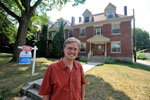
Kendall Pelling, project manager with East Liberty Development Inc., stands in front of a home acquired by the nonprofit development group and renovated along Baywood Street in East Liberty. Justin Merriman/Pittsburgh Tribune-Review
“Legislation at the state level … will help communities deal holistically with abandoned properties. They can be moved into public ownership more quickly,” said Kendall Pelling, project manager at East Liberty Development Inc., a nonprofit development corporation working to help revitalize the community.
Abandoned buildings are “impeding community and economic development programs and conveying images of old, worn-out communities,” said Joanna Demming, director of the Southwestern Pennsylvania office of The Housing Alliance of Pennsylvania.
Their impact is felt in communities such as Etna, a close-knit town where men once walked to work in nearby mills. The borough’s population was 7,493 in 1930 but dwindled to 3,560 by 2008, according to U.S. Census Bureau figures.
“I could see my wife hanging laundry in the yard while I was at work,” recalled Sigmund Dziubinski, 80, of Oakland Street. “It was a different era. You lived and worked in the town.”
Rent, raze or remodel?
The house at 5506 Baywood St. in East Liberty had been abandoned for 10 years and was ready for the wrecking ball, neighbors said.
“It took a leap of faith to rehabilitate it,” said Gary Cirrincione, who lives nearby and serves on the Negley Place Neighborhood Alliance, a community group of “urban activist-types and people with an appreciation of historic housing” that has been working to revitalize the neighborhood for the past 20 years.
“We’ve been called the Woodstock generation,” Cirrincione said.
The effort is paying off; the neighborhood is turning around.
The house across the street from 5506 is being restored. Down the block, another. A couple of streets over, houses that once stood empty contain families.
“We have properties on Baywood that would have sold lower. If you can do the right intervention, you can stabilize the market,” said Kendall Pelling, project manager at East Liberty Development Inc., a nonprofit development group involved with the purchase, sale or renovation of 102 properties during the past three years.
A house bought in foreclosure in 2007 for $55,000 was sold last year for $310,000. Another former tax foreclosure property that underwent extensive renovation is for sale; its asking price is $324,900.
As in neighborhoods in other towns across Pennsylvania, absentee landlords were a problem in East Liberty.
“There’s a tendency to slap a coat of paint on it and rent it as is. … Milk the building, and then walk away,” Cirrincione said.
Darleena Butler watched a lot of rehab work along Baywood in the three years she has lived there. More remains to be done. The house across the street has been empty for a year; the one next door is for sale.
“Instead of tearing them down, remodel,” Butler said. “That brings new life into the neighborhood.”
Nobody’s homeUsing data provided by the U.S. Postal Service, the Pittsburgh Neighborhood and Community Information System classified 8,555 of the 160,000 residential addresses in Pittsburgh as “vacant” during the third quarter of 2009 and another 8,995 as “not ready for occupancy.”
In Allegheny County, 20,730 of 603,000 residential addresses were vacant during that period while 23,387 were not ready for occupancy, the group reported.
Source: Pittsburgh Neighborhood and Community Information System
-
Plan OK’d to Raze UPMC Braddock
CCAC campus and medical clinic planned for siteThursday, September 16, 2010By Deborah M. Todd, Pittsburgh Post-GazetteDuring an emotional meeting, at which the death of Councilwoman Millie Devich was marked with a moment of silence and a bouquet of flowers behind her nameplate in council chambers, motions designed to address Braddock’s financial future added to the fervor.
Borough council voted, 4-0, to approve a memorandum of understanding among the borough, UPMC and the Allegheny County Redevelopment Authority regarding a plan to demolish UPMC Braddock and replace it with a multiuse facility.
Councilman Milan Devich was not in attendance.
The memo calls for UPMC to pay for the hospital’s demolition, estimated at about $5 million, to make way for the potential construction of a building that would feature a Community College of Allegheny County campus as well as a medical clinic.
Most of the land currently being used for parking would be used for new housing, but the Braddock Avenue lot where the former Sky Bank sat would be turned over to the borough once the Redevelopment Authority acquires the title.
The borough also would receive $90,000 per year for the next five years from UPMC as part of the deal.
UPMC would contribute $3 million toward the proposed $29 million development, but that sum is contingent upon the county receiving $3 million from the state to match the effort.
Solicitor M. Lawrence Shields said the state had already earmarked the funds for the borough.
Mr. Shields said the memo should be considered in conjunction with a recent agreement settling a federal civil rights claim filed against UPMC by council President Jesse Brown.
The U.S. Department of Heath and Human Services’ Office of Civil Rights reached an agreement with UPMC to provide door-to-door transportation for Braddock residents to an outpatient site in Forest Hills and to UPMC McKeesport.
It also requires UPMC to provide six health screenings per year in the community; to have a patient liaison assist residents having difficulties accessing care; to assist health ministries in local churches; and to place strong emphasis on preventative care with its “Steps to a Healthy Community” program.
The agreement is in effect for three years.
“This is a package deal, so to speak, where both of these agreements interrelate,” said Mr. Shields. “Hopefully, through both of these agreements, we believe we’ve obtained the most we could possibly obtain under the circumstances.
“Believe me when I tell you we tried very, very hard to obtain as much as we possibly could for the citizens of Braddock.”
Mr. Brown said HHS representatives would discuss terms of the civil rights settlement at a meeting at 7 p.m. Wednesday at the Blazing Bingo Hall on Talbot Avenue.
Choking up during some points of his speech, Mr. Brown encouraged religious leaders, residents and public officials to come to hear exactly how much Braddock had gained thanks to efforts by local officials, and how much it stood to lose without those efforts.
“UPMC wouldn’t give us nothing,” Mr. Brown said. “They would have walked away and would have given Braddock nothing. But we do have some services that are a part of this agreement. We’re going to have an urgent care center, which we didn’t have before, that will be beneficial to the residents of this community.”
In the aftermath of the suspension of borough manager Ella Jones, council approved a number of measures designed to detect and prevent fraud.
Ms. Jones, 58, of Turtle Creek is accused of embezzling more than $170,000 from the borough since 2008.
From now on, all paper checks issued can come from only the borough’s general fund and payroll accounts. If funds from the remaining deposit-only accounts are needed in the event of an emergency, the money would have to be transferred to the general fund to write the check.
All emergencies must be explained to council in writing. Council also started a policy of reviewing a list of bills before approving payment each month.
Interim borough manager Paul Leger was authorized to sign off on borough checks, along with Mr. Brown and Vice President Matthew Thomas.
Mr. Leger also was appointed to the Southeast Allegheny Tax Collection Committee for Earned Income Tax Collection. Councilwoman Tina Doose was appointed to the finance committee.
Mr. Leger said the moves were an attempt to bring the borough in line with earlier suggestions made regarding the borough’s financial controls.
“This stuff is boring, but necessary to bring us in compliance with our audit recommendations,” he said.
-
Money Tagged for I-579 Project Could Be Used at New Arena
By Jeremy Boren
PITTSBURGH TRIBUNE-REVIEW
Monday, September 13, 2010Federal money intended to plug an unsightly concrete gap next to Interstate 579 might be used at Consol Energy Center instead.
At the request of the Urban Redevelopment Authority of Pittsburgh, Sen. Bob Casey proposed redirecting the $974,000 earmark to pay for most of a walkway that would hug the exterior of the Penguins’ new home and connect its Fifth Avenue and Centre Avenue entrances.
People working on a master plan for the Lower Hill District and trying to preserve the Civic Arena question whether a Consol walkway is the best use of federal money in a neighborhood struggling with crime and poverty.
“If we’re going to move it around anyway, we need it for public safety on Centre Avenue,” said Carl Redwood, founder of the Hill District Consensus Group. “That takes priority.”
Redwood supports the concept of the $1.5 million walkway at Consol but said his group lobbied city police to address concerns about drug deals occurring near the Zone 2 station on Centre, not far from the arena.
Casey, D-Pa., declined to say whether he believes there’s a better use for the money, but he’s aware no consensus exists.
“If there are better ways to target the dollars, we try to be responsive to that. It doesn’t always work,” the senator said. “What I try not to do is to be an urban planner or a local government official. That really has to be a decision made here in Pittsburgh.”
The Consol walkway, dubbed “Curtain Call” by California artist Walter J. Hood, would feature 15-foot-tall stainless-steel curtains, a lighted path and photos of Hill District life embedded in the steel sheets.
URA Executive Director Rob Stephany said an “engineer’s sketch” of the I-579 “cap” project between the Hill District and Downtown would cost an estimated $15 million.
The original application for federal money from Casey’s office touts the cap as “a new urban green space that finally reconnects the Lower Hill District to downtown.”
After learning from the Sports & Exhibition Authority, which owns the new $321 million arena, that it lacked enough money to pay for Curtain Call, URA officials requested the money from Casey, Stephany said.
Rob Pfaffmann, a Downtown architect and frequent critic of the hockey team’s desire to demolish the Civic Arena and develop its 28-acre site, supports Curtain Call. Pfaffmann formed the grass-roots group Reuse the Igloo.
He believes the connection between Fifth and Centre is crucial because walking outside from one side of Consol to the other is difficult.
“Frankly, the Penguins should have paid for it,” Pfaffmann said.
In 2007, the Penguins agreed to contribute $4.1 million a year for 30 years to pay for part of the arena. Pittsburgh’s Rivers Casino pays $7.5 million a year from gambling revenue, and the state funding fueled by casino taxes chips in another $7.5 million a year.
The city Planning Commission required the walkway at the arena, Stephany said, noting the team never wanted anything so elaborate.
“We kind of fell in love with that notion of a public art project and pedestrian way,” he said.
The walkway would be open to everyone, not just hockey fans, he said.
“Will it make for a great experience for people at a game? Yes. Will it make for a great connector for a student on his way to a grocery store? Yes.”
-
Poke Run Presbyterian Church Divided Over Historic Building
By Chuck Biedka, VALLEY NEWS DISPATCH
Friday, September 10, 2010
Last updated: 7:11 am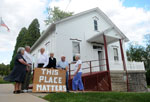
From left, Emma and Jim Dunmire, of Washington Township; Jack and Eleanor Zerbini, of Salem Township; Maynard Miller, of Kiski Township; and Kathy Moneymaker, of Washington Township, all gather together in front of the Academy Building located beside the Poke Run Church located in Washington Township on Thursday. Erica Hilliard/Valley News Dispatch
Nine members of Poke Run Presbyterian Church are asking Westmoreland County Court to side with history and preserve the church’s academy building and its contents.
The four couples and one individual filed a lawsuit Thursday to stop their congregation from demolishing the academy building and prevent the sale of antiques or other items inside.
Trustees insist that the congregation followed all congregational and Redstone Presbytery rules when it voted, 61-49, in June to demolish the wooden academy building, said trustee Vice President Walt Lange yesterday.
Trustee President Vince Goodiski said the congregation, organized in 1785, attracts 150 people to its two Sunday services. The church is located along Poke Run Church Road in Washington Township, across Route 66 from the intersection with Route 366.
Goodiski, a member since the 1980s, said the members voted to use the space to add an elevator and ground-floor access to the fellowship hall in the basement of the church.
The academy building has “no amenities, a crumbling foundation, musty smell,” and its metal roof recently sustained wind damage, he said.
Goodiski also said an older $10,000 ramp leading to the front of the church is inadequate and, at the back of the church, a $7,000 chair lift needs to be replaced to accommodate wheelchairs.
“It’s not feasible to fix the lift, and people who use the ramp and come into the church late are immediately seen by everyone else,” he said.
The nine members believe the handicap access is sufficient, and they want to have the building that opened in 1889 classified as a historic structure, member Maynard Miller said.
Both sides in the dispute retain deep emotional attachment to the church, even if they disagree about the fate of the academy building. Many have attended the church for decades.
Miller, whose name appears first on the lawsuit, said the academy served as the township’s first high school, starting in about 1919 and lasting about 10 years.
Miller said his wife, Martha, was baptized in the church, and she married him there in 1946.
James W. Dunmire is among those who are asking for an injunction.
“This is historic. We don’t want the building destroyed,” Dunmire said.
Goodski said the congregation has dealt with the issue for “at least five or six years” and this is “not something that came up as a last minute thing as they are trying to say.”
Goodski said they have offered the building to the nine “and anyone else to move it.”
One solution may be to “put the building on a slab” and move it elsewhere on the church property, he said, although that could be tricky because of the condition of the academy and its maintenance budget.
Goodiski could not say how much the church has spent on the building.
The church land includes the academy and church as well as an education building.
Goodiski and Lange believe the education building can be enlarged to handle community meetings, including those for the Kiski Valley Habitat for Humanity and Beaver Run Community 4-H Club.
He said the congregation wants to remove the building “so that we can better reach out into the community.”
The complaint includes a request for an injunction but a hearing on that hasn’t been scheduled.
-
Hiding in Plain Sight: A House as Old as Larryville
The house on the southwest corner of 38th St. and Charlotte Street in Lawrenceville is up for sale. It was bult a decade after Lawrenceville became a town in 1814.
We know this because house historian Carol Peterson, a denizen of Larryville, researched the records. The house you see now — ruddy-colored clapboards, patched in part with old tin advertisements — encloses the original log home that was built in the 1820s. The “new” part is from the 1870s. That’s Michael Connors in front of it. Michael has been part of the Lawrenceville Historical Sociaty’s efforts over the years to get it, and to have it renovated.
Read Michael’s “Next Page” in the Post-Gazette on Sept. 12 for a story about one of the buildings past inhibitants, a teenager who packed munitions and died in the deadly arsenal explosion of 1882. And, by the way, thanks to Matt Smith, who was walking along with a smart phone and agreed to take the photo you see. (So, OK, the sun was in the wrong place.)
For some time, heavy hitters including the Pittsburgh History and Landmarks Foundation, Sen. Jim Ferlo and other public officials, were at least cheering on the historical society’s effort, Michael tells me.
Arthur Ziegler, president of Landmarks, said the interest and needed money could not be reconciled. “We don’t have many log houses left and we would like to save them,” he said, “but this had been so changed over the years, to put it back the way it was would have meant cutting new logs.”
The historical society “knew it was way beyond our ability” to afford and renovate, Michael said.
It is owned by a limited partnership. Historical Society members toured it a few years ago when the owners wanted $39,000. We’re trying to find out the asking price from the Realtor.
This building was part of the original town of Lawrenceville that composer Stephen Foster’s father subdivided. In 1841, Lawrenceville town was carved out of Pitt Township roughly from 38th to 41st Streets and from Woolslayer to the Allegheny River, Carol said. Lawrenceville was incorporated as a borough in 1834.
“Just think that someone in this house could have walked up the street to see the Marquis de Lafayette when he visited Pittsburgh” in 1825, Michael said. In case history isn’t your subject, Lafayette was a hero of both the French and American revolutions and knew George Washington.
He was our first president.
Michael said his dream is that UPMC, whose Children’s Hospital presence is “the biggest and newest” in the neighborhood, offers the needed largesse “for the smallest and oldest” and help Lawrenceville showcase one of its original structures, which could be an attraction for visitors to the hospital.
Walkabout is putting it out there, like a butterfly wish that might merge with the fluttering fancy of the right person…or institution.
-
Sculpture of Steel Worker to Highlight Natrona Heritage Park
By Tom Yerace, VALLEY NEWS DISPATCH
Tuesday, September 7, 2010Natrona’s history is forever linked to industry, and that is the focus of a new park being planned there.
“We’ve been working with Pittsburgh History and Landmarks Foundation, and one of the focuses of Natrona Comes Together is to preserve the history of Natrona,” said Bill Godfrey, president of the grassroots neighborhood improvement group, in discussing the proposed Natrona Heritage Park.
Natrona’s first major industry was salt mining by The Pennsylvania Salt Manufacturing Co. dating to 1850. In fact, Godfrey said the park site, which is about 100 feet by 100 feet, is the site of the old Penn Salt company store.
Although Penn Salt evolved into a chemical conglomerate, it eventually became overshadowed in Natrona by the steel industry and Allegheny Ludlum Steel Corp., now known as ATI-Allegheny Ludlum.
It is the steel industry that is the focus of the heritage park, according to Godfrey and Stephen Paulovich, the New Kensington native who is a renowned Louisville, Ky.-based sculptor.
Paulovich is known throughout the Alle-Kiski Valley for his sculptures at the coal miners memorial in Harmar and for the statue of New Kensington football legend Willie Thrower at Valley High School’s stadium.
According to Paulovich, the park’s dominant structure will be a sculpture of an 8-foot-high steel worker set on a base that will have the sculpture rise 18 feet above the park.
In addition, there will be smaller sculptures of buildings in Natrona, some of which still exist, he said.
Paulovich said he will donate his services, including any foundry work.
“I was trying to get something more public art-oriented,” Paulovich said. “Things that are more historical that kids can walk around and look at.
“We want to incorporate some of the buildings … some of them might (still) be there, some might not,” he added. “Those buildings were so important. And if it wasn’t for steel, they wouldn’t be there.”
Among the buildings Paulovich included in his initial drawings were the Pond Street School, St. Ladislaus Church and the Windsor Hotel.
“People in New Kensington might get mad at me, but I think Natrona is the gem, architecturally, of that area,” he said.
Paulovich and Godfrey said they plan to put the project in motion within the next week or two.
They and Natrona Comes Together are developing the project with Frank McCurdy of Harrison, who taught architecture at the University of California, Berkeley, before retiring. He also is a member of the Natrona Comes Together board, Godfrey said.
“We have absolutely no money for it yet, but we have strong passion for finding funds,” Godfrey said.
“We’re going to approach Allegheny Ludlum and the unions and get some other private financing,” he said. He said that they don’t have a firm cost estimate yet. “We’ll give a presentation to anybody that will be very clear and will leave nothing to the imagination. It will be like ‘This is what you get for your dollar.’ It will be like selling any other product.
“I think it is only fair that Allegheny Ludlum celebrates the history of the steel workers who actually built the company with their sweat and toil,” Godfrey said. “We have not approached them, but we are very excited about trying to get them to donate.
“It could be a model for how a steel mill improves the quality of life for a community.”
To underscore the community’s ties to steelmaking even further, Paulovich wants to cast the sculptures in stainless steel, Allegheny Ludlum’s core product for decades.
“I was going to do it in bronze, but it just doesn’t make sense. Bronze? In a steel town?” Paulovich said. “If the guys are making stainless down there, why can’t we use stainless/”
Also, Paulovich wants those “guys” to be involved with the project.
“We want to get some of the welders from Allegheny Ludlum to come down and help us put this together for us,” he said. “I don’t sweat like they do in 4,000 degrees; they need this. It’s just amazing what they do. They have to do it, it’s going to be their sculpture.”
“For them to drive by with their kids and hear them say, ‘Hey, Dad did that,’ that would be great,” Paulovich said.
-
Fire Engine House in North Point Breeze Up for Sale
Offers due Oct. 22; tour set ThursdayMonday, September 06, 2010By Joe Smydo, Pittsburgh Post-Gazette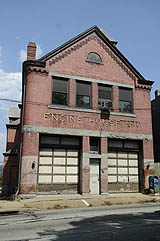
The Engine No. 16 firehouse in North Point Breeze is up for sale. Proposals for use of the space are due Oct. 22 and guidelines are posted for would-be purchasers. Rebecca Droke/Post-Gazette
The fire trucks and alarm bells may be long gone, but city officials believe Engine House No. 16 still has a dynamic role to play in the East End.
Officials said they’d like to sell the building and have posted guidelines for would-be purchasers. The request for proposals is on www.buyintheburgh.com, a year-old database of properties for sale by the city and Urban Redevelopment Authority.
The two-story, red-brick building is at Penn and North Lang avenues in North Point Breeze. Built in the early 1900s, it has 6,500 square feet of space and an appraised value of $90,000. Other features are two drive-in bays, 16-foot ceilings and a full basement.
The engine house’s name still adorns the front of the structure.
“It’s a gorgeous building,” said URA executive director Rob Stephany.
The city stopped using the building as a fire station in the late 1980s or early 1990s, but it’s still used to provide classroom training to firefighters. Overall, the URA said, it’s in fair condition.
Mr. Stephany said the building is well suited for an architect’s studio, condominiums or a home-business combination. Claire Hosteny, URA senior real-estate development specialist, said one drawback is a lack of parking space outside.
Proposals are due to the URA by noon Oct. 22. A walk-through is scheduled for 9 a.m. Thursday.
No public subsidies are available for renovation. The URA is helping to vet proposals, but the decision to sell rests with City Council and the mayor’s office.
In other cities, old firehouses have been converted into homes and businesses. In March, Chicago officials decided to seek redevelopment proposals for the old Engine Co. 18 firehouse, a two-bay structure built in 1873 on the city’s Near West Side. Officials said they’re interested in a commercial or mixed-use development.
Mr. Stephany said redevelopment of the North Point Breeze building can have a “catalytic impact” on a part of the city poised for progress. He said the development opportunity comes amid a master-planning process for the Homewood-North Point Breeze area.
In highlighting the firehouse development opportunity last week, officials also sought to focus renewed attention on the property website, which lists about 4,300 properties for sale. Properties may be searched by address and neighborhood. The website provides details on each property and has information on the city’s tax-abatement and green-up programs.

